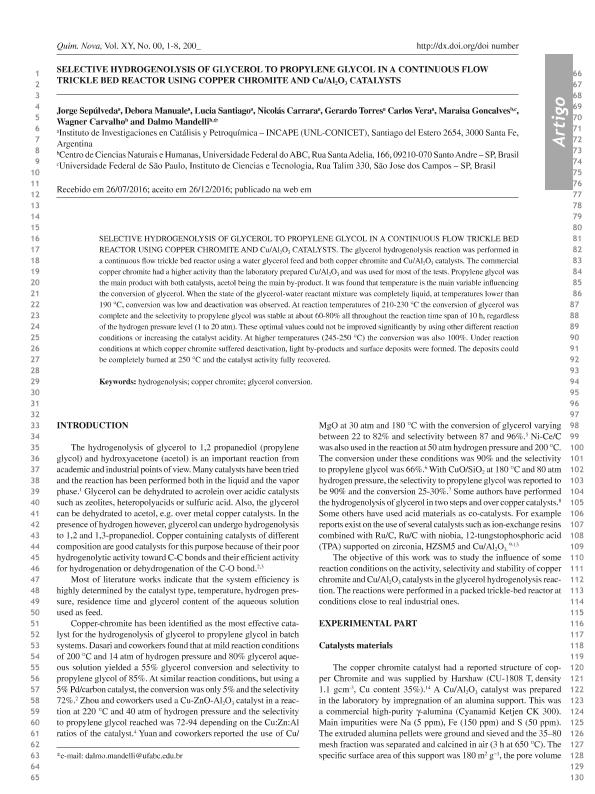Artículo
Selective Hydrogenolysis of Glycerol to Propylene Glycol in a Continuous Flow Trickle Bed Reactor Using Copper Chromite and Cu/Al2O3 Catalysts
Sepúlveda, Jorge; Manuale, Débora Laura ; Santiago, Lucía; Carrara, Nicolás Ricardo
; Santiago, Lucía; Carrara, Nicolás Ricardo ; Torres, Gerardo; Goncalves, Maraisa; Carvalho, Wagner; Mandelli, Dalmo
; Torres, Gerardo; Goncalves, Maraisa; Carvalho, Wagner; Mandelli, Dalmo
 ; Santiago, Lucía; Carrara, Nicolás Ricardo
; Santiago, Lucía; Carrara, Nicolás Ricardo ; Torres, Gerardo; Goncalves, Maraisa; Carvalho, Wagner; Mandelli, Dalmo
; Torres, Gerardo; Goncalves, Maraisa; Carvalho, Wagner; Mandelli, Dalmo
Fecha de publicación:
12/2016
Editorial:
Sociedade Brasileira de Química
Revista:
Química Nova
ISSN:
0100-4042
e-ISSN:
1678-7064
Idioma:
Inglés
Tipo de recurso:
Artículo publicado
Clasificación temática:
Resumen
The glycerol hydrogenolysis reaction was performed in a continuous flow trickle bed reactor using a water glycerol feed and both copper chromite and Cu/Al2O3 catalysts. The commercial copper chromite had a higher activity than the laboratory prepared Cu/Al2O3 and was used for most of the tests. Propylene glycol was the main product with both catalysts, acetol being the main by-product. It was found that temperature is the main variable influencing the conversion of glycerol. When the state of the glycerol-water reactant mixture was completely liquid, at temperatures lower than 190 °C, conversion was low and deactivation was observed. At reaction temperatures of 210-230 °C the conversion of glycerol was complete and the selectivity to propylene glycol was stable at about 60-80% all throughout the reaction time span of 10 h, regardless of the hydrogen pressure level (1 to 20 atm). These optimal values could not be improved significantly by using other different reaction conditions or increasing the catalyst acidity. At higher temperatures (245-250 °C) the conversion was also 100%. Under reaction conditions at which copper chromite suffered deactivation, light by-products and surface deposits were formed. The deposits could be completely burned at 250 °C and the catalyst activity fully recovered.
Palabras clave:
Hydrogenolysis
,
Copper Chromite
,
Glycerol Conversion
Archivos asociados
Licencia
Identificadores
Colecciones
Articulos(INCAPE)
Articulos de INST.DE INVEST.EN CATALISIS Y PETROQUIMICA "ING. JOSE MIGUEL PARERA"
Articulos de INST.DE INVEST.EN CATALISIS Y PETROQUIMICA "ING. JOSE MIGUEL PARERA"
Citación
Sepúlveda, Jorge; Manuale, Débora Laura; Santiago, Lucía; Carrara, Nicolás Ricardo; Torres, Gerardo; et al.; Selective Hydrogenolysis of Glycerol to Propylene Glycol in a Continuous Flow Trickle Bed Reactor Using Copper Chromite and Cu/Al2O3 Catalysts; Sociedade Brasileira de Química; Química Nova; 26; 8; 12-2016; 1551-1564
Compartir
Altmétricas



